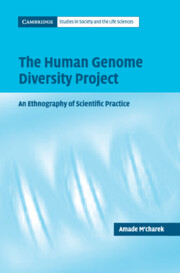Book contents
- Frontmatter
- Contents
- Preface
- 1 Introduction
- 2 Technologies of population: making differences and similarities between Turkish and Dutch males
- 3 Ten chimpanzees in a laboratory: how a human genetic marker may become a good genetic marker for typing chimpanzees
- 4 Naturalization of a reference sequence: Anderson or the mitochondrial Eve of modern genetics
- 5 The traffic in males and other stories on the enactment of the sexes in studies of genetic lineage
- 6 Technologies of similarities and differences, or how to do politics with DNA
- Glossary
- References
- Index
4 - Naturalization of a reference sequence: Anderson or the mitochondrial Eve of modern genetics
Published online by Cambridge University Press: 06 July 2010
- Frontmatter
- Contents
- Preface
- 1 Introduction
- 2 Technologies of population: making differences and similarities between Turkish and Dutch males
- 3 Ten chimpanzees in a laboratory: how a human genetic marker may become a good genetic marker for typing chimpanzees
- 4 Naturalization of a reference sequence: Anderson or the mitochondrial Eve of modern genetics
- 5 The traffic in males and other stories on the enactment of the sexes in studies of genetic lineage
- 6 Technologies of similarities and differences, or how to do politics with DNA
- Glossary
- References
- Index
Summary
Introducing the argument
Technologies are locally mediated scientific practices. And standardized technologies are not fixed but “achieved in process.” This was the topic of Chapter 3. Often, however, technology is treated as an autonomous entity; once produced it leads a context-independent life and is rendered self-evident in various different contexts. It becomes naturalized. The naturalization of technology not only presents it as a clearly defined entity; it also obscures the normative content of technology. Questions about how a technology might affect the world, thereby move to the background. This chapter deals with the naturalization of a standardized technology. It examines both its ideological content and how it is made into an autonomous entity. The argument is that since technology is always produced somewhere and is made to work in a specific context, its naturalization also requires work. What kind of work this is and how it is carried out is the main concern of the present chapter.
In February 2001, the sequence of the complete human genome was presented to the world. We also learned that the work of the Human Genome Project was not yet complete and that substantial parts of that genome were still being mapped. However, in 1981, a complete sequence of another human genome was produced in Cambridge. Not a sequence of nuclear DNA, but that of the mitochondrial DNA (mtDNA). Ever since its publication, this sequence had become the reference genome for geneticists.
- Type
- Chapter
- Information
- The Human Genome Diversity ProjectAn Ethnography of Scientific Practice, pp. 84 - 119Publisher: Cambridge University PressPrint publication year: 2005



